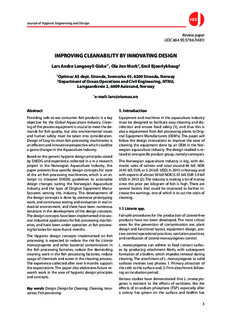| dc.contributor.author | Giske, Lars André Langøyli | |
| dc.contributor.author | Mork, Ola Jon | |
| dc.contributor.author | Bjørlykhaug, Emil | |
| dc.date.accessioned | 2018-01-05T09:07:13Z | |
| dc.date.available | 2018-01-05T09:07:13Z | |
| dc.date.created | 2018-01-04T10:48:55Z | |
| dc.date.issued | 2017 | |
| dc.identifier.citation | Journal of Hygienic Engineering and Design. 2017, 21 3-9. | nb_NO |
| dc.identifier.issn | 1857-8489 | |
| dc.identifier.uri | http://hdl.handle.net/11250/2475882 | |
| dc.description.abstract | Providing safe-to-eat consumer fish products is a key objective for the Global Aquaculture Industry. Cleaning of the process equipment is crucial to meet the demands for fish quality, but also environmental issues and human safety must be taken into consideration. Design of Easy-to-clean fish processing machineries is an efficient and innovative perspective which could be a game changer in the Aquaculture Industry. Based on the generic hygienic design principles stated by EHEDG and experience collected in a in a research project in the Norwegian Aquaculture Industry, this paper presents four specific design concepts for state of the art fish processing machineries, which is an attempt to interpret EHEDG guidelines to actionable design changes suiting the Norwegian Aquaculture Industry and the type of Original Equipment Manufacturers serving this industry. The development of the design concepts is done by extensive prototyping work, and continuous testing and evaluation in real industrial environment, and there have been numerous iterations in the development of the design concepts. The design concepts have been implemented into several industrial applications for fish processing machineries, and have been under operation at fish processing factories for more than 6 months. The Hygienic design concepts implemented on fish processing is expected to reduce the risk for Listeria monocytogenes and other bacterial contamination in the fish processing factories, reduce the demanding cleaning work in the fish processing factories, reduce usage of chemicals and water in the cleaning process. The experience collected after over 6 months support the expectations. The paper also elaborates future research work in the area of hygienic design principles and concepts. | nb_NO |
| dc.language.iso | eng | nb_NO |
| dc.publisher | Consulting and Training Center KEY | nb_NO |
| dc.relation.uri | http://www.jhed.mk/categories/view/472/457 | |
| dc.subject | Design for vasking | nb_NO |
| dc.subject | Design for Cleaning | nb_NO |
| dc.subject | Innovasjon | nb_NO |
| dc.subject | Innovation | nb_NO |
| dc.subject | Fiskeprosessering | nb_NO |
| dc.subject | Fish processing | nb_NO |
| dc.subject | Renhold | nb_NO |
| dc.subject | Cleaning | nb_NO |
| dc.title | Improving cleanability by innovating design | nb_NO |
| dc.type | Journal article | nb_NO |
| dc.type | Peer reviewed | nb_NO |
| dc.description.version | publishedVersion | nb_NO |
| dc.subject.nsi | VDP::Teknologi: 500 | nb_NO |
| dc.subject.nsi | VDP::Technology: 500 | nb_NO |
| dc.source.pagenumber | 3-9 | nb_NO |
| dc.source.volume | 21 | nb_NO |
| dc.source.journal | Journal of Hygienic Engineering and Design | nb_NO |
| dc.identifier.cristin | 1535571 | |
| dc.relation.project | Norges forskningsråd: 245613 | nb_NO |
| dc.description.localcode | © 2017. Published by Consulting and Training Center KEY. Open Access. | nb_NO |
| cristin.unitcode | 194,64,93,0 | |
| cristin.unitname | Institutt for havromsoperasjoner og byggteknikk | |
| cristin.ispublished | true | |
| cristin.fulltext | original | |
| cristin.qualitycode | 1 | |
